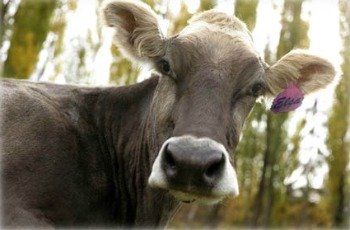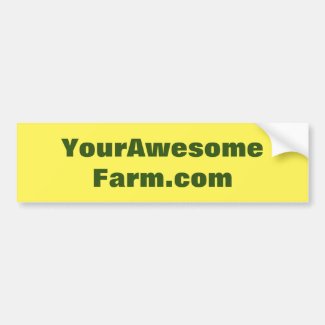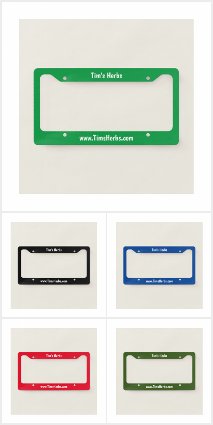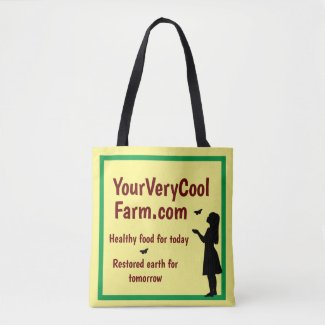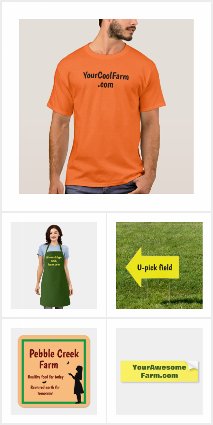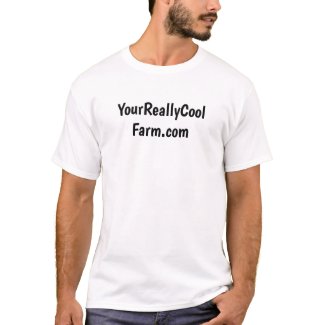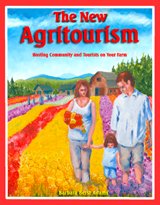Micro dairy starts & succeeds with 5 cows!
Holy (and hardy) cows!
How 5 brown cows help micro dairy reach success
by Barbara Berst Adams
Copyright National Lilac Publishing, LLC A version of this article was first published in AcresUSA.
On
a rocky hillside in the rugged Cache Valley of northern Utah, five
Swiss Brown cows graze about 5.5 acres (4 owned, 1 ½ leased). The
really interesting part of this lovely vision is that their milk
provides the full time living for the owners of Rockhill Creamery,
Jennifer Hines and Pete Schropp, a husband and wife team who turn the
milk into artisan cheese.
How they do it
How?
Well, there’s an old truth in Northern Europe among
traditional dairy farmers. They say you can tell which meadow the milk
and cheese came from, because the flavor is different depending on the
herbs grown in the different fields. This ability to taste and
to desire the differences in different locations hasn’t died completely,
and it may be returning to the USA (and hopefully the world) in many
forms, including local eco-dairies.
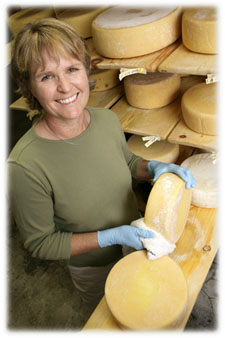
It’s
an example of a revival of a way of sustainable farming. The deeper we
get into regenerative and local production, the more new pathways open
up to reveal a treasury of lost taste diversity, flavor and food
producing methods. They reveal just how exciting and unique the foods are
that wait to be discovered from country to country, from region to
region, and maybe even from meadow to meadow.
In
this author’s opinion, Rockhill Creamery is tapping into this revival
that’s even beyond the more obvious foodie and sustainability trends. It's reaching into the regenerative realm.
Beyond sustainability
Their cows are antibiotic-free,
rBGH-free, and eat grass and clover when it isn’t snowing. “Our pastures
are a combination of blue grass and clover,” Pete says. “We have tried
to keep them in more productive grasses, but we are surrounded by houses
with blue grass yards and blue grass is very competitive. We are able
to control weeds through mechanical means, and by rotating between cows,
heifers, smaller steer calves, and horses, we get a pretty good, even
graze.
"Sometimes, in the early spring, I do mow some of the high spots. We do harrow frequently. Since our farm is so small, our pastures are not the sole source of feed for our cows.
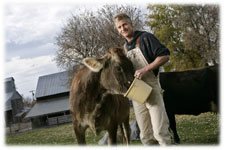
"They also eat locally grown premium dairy hay and a grain ration that has been customized for our small herd.” Pete and Jennifer’s supplements include alfalfa, some soy, corn and barley, and of course, minerals.
“We provide our cows with free choice minerals and salt. I offer them
one commercial block of trace minerals, one chunk of southern Utah
mineral salt (from the Redmond Salt Company -- the RealSalt™ people),
and a regular white salt block also.”
But
the story, the flavor, and the request from customers – including
chefs, gets deeper than this. Cheese from Rockhill Creamery is not just
cheese from generic sustainably raised cows. “We have a very nice
mineral package in our custom grain ration that they are fed twice daily
while in the milk parlor,” explains Pete. “We have a friend that helped
us develop our own ration ... no urea, or other animal sources of
protein. We use whole, flaked soybeans for our protein, whole, flaked
corn and barley for the energy. It costs us quite a bit more than the
standard dairy ration available at our co-op, but we have had several
chefs actually request copies of the ingredients lists for what our cows
eat, so our customers are quite involved with how we choose to feed our
cows.”
Further,
the creamery’s milk for cheese currently comes from Elsa, Ingrid,
Greta, a new gal named Chloe, plus the beloved Ruby, who came down with
pneumonia last
winter, but then made an inspiring recovery after the careful care
given by her owners combined with her own strength and will to live.
While all the cows are pampered and respected by their owners, they also
must become rugged and healthy themselves against the harsh white
northern Utah winters. Cheese from Rockhill Creamery is different than
that from other regions and other meadows. It’s from, as the owners
describe them, very hardy cows, and also of a unique breed of cow.
“Brown
Swiss produce milk with almost the perfect protein to butter fat ratio
for cheese making," says Pete. “We knew that we wanted to make whole-milk
cheeses, so that was important to us. The yield we get is quite high
because of that ratio. Brown Swiss are also the most beautiful of all
breeds (I am not biased in any way!). And they are the most docile --
very easy to be around, and very safe for the milker.”
Fans
of their cheese can enjoy the farm owners’ blog, entitled “Holy Cows,” a
high-tech form of the old farm journal non-farmers often love to read
and live vicariously through. It's a great farm promotional tool. We can read about how the cows love
playing in the snow, how Ruby, when ill, was covered with a blanket and
treated by the vet, and of her remarkable recovery. We can see how the
progress of the new aging room is coming along, and smile at Pete’s
amusing description of what happened when the bull was brought in.
And
their cheese-making is definitely artisan. It begins, of course, with
receiving very good milk from their Brown Swiss cows. They use
cow-to-can milking with a machine, but no pipeline. (Pete says they
can't be grade A with an open pail.) They use this high quality raw
milk with a variety of cultures to produce artisan cheeses that are
aged in their aging “cave.” The aging time is broken down into three
stages, offering a milder creamier cheese after the shortest duration,
and a harder cheese with deeper, complex flavors for the cheese with the
longer term aging. Cheese flavors include Farmhouse Gouda with its
hand-rubbed olive oil rind, Zwitser (which means “Swiss” in Dutch) for
which is added an extra enzyme to the Farmhouse Gouda to create a
flavorful variation, Peppercorn made with whole black peppercorns, Dark
Canyon Edam aged between two to four months and named after a favorite
canyon in Utah – a cheese which changes to Snow Canyon Edam after it
ages longer, more than four months, also named after another Utah
canyon. There's also a rich flavored Wasatch Gruyere, and their own cows-milk Desert
Red Feta rubbed with red salt minerals mined from Southern Utah.
How it all started
“We had been raising baby dairy heifers as replacements for some area dairies,” says Pete. “We had invested quite a bit of money and time into the business, and it seemed as though each time we just started to make some money and settle into a good working relationship, the dairy would close or go out of business. So we decided that we needed to come up with a business plan that gave us more control over our own destiny. Our farm is too small to be profitable, unless we added value to what we produced, so after considering many options, we decided the cheese business was the perfect fit for us. I really enjoy working with livestock, and Jennifer is a true "foodie."
Their market outlets
Pete and Jennifer sell their cheeses to various restaurants with names
including Deer Valley Resort and Garden Café, to retail foods markets
such as one named Sweet Peas Natural Market, and online in the form of
gift boxes, samplers, or wheels of cheese, from a quarter wheel to full
wheels. They have also established a cheese club membership where
customers can choose from a variety of subscription packages to have
cheese delivered on a regular basis.
In
addition, they operate a farmstand in their granary which they open on
Saturdays from 11 a.m. to 4 p.m. May through October. For other times,
they allow potential farm visitors to call ahead if they want to visit
the farm when the farmstand isn’t open. Their farmstand offers cheese
samples and they also sell other locally produced food items, such as
artisan bread from a producer named Crumb Brothers Artisan Bread.
The road to ultimate success
Pete
explains here how many other individuals and entities, from local
specialty food shop owners to the Slow Food Movement, helped make their
dairy a success. “When we first decided to get into the cheese business,
we introduced ourselves to the owner of one of Salt Lake City's best
specialty food shops - Liberty Heights Fresh. Steven Rosenberg is a
well-known supporter of local producers of all types. He showed quite an
interest. It took us two years to complete all the buildings, etc. When
we were finally licensed in January 2005 we got in touch with Steven
again, and he came to visit us that March. Ever since he has been a
great ally. He helped us get a spot at the Salt Lake Downtown Farmers
Market - a very large market that exposed us to thousands of folks. He
steered media folks our way, including a reporter for Via Magazine, the
West's AAA travel magazine with several million readers.
“That
same year we sold at the Cache Valley Gardeners Market here in our
valley. So, with the exposure that we received from the two farmers
markets, as well as the media, we were well on our way to developing a
recognized brand.
“In
2006 we added the Park City Farmers market to our outlets and began
approaching stores and restaurants - mostly in person, but some through
letters and samples shipped. That summer, the Utah chapter of Slow Food,
USA held a "farmer/chef mingle" in Salt Lake City and invited chefs
from the area's fine restaurants, hotels and ski resorts. We met several
chefs for the first time, and got to see others in a much more casual
setting than their kitchens. Then, that fall, we hosted a Slow Food Utah
event here at our farm. We had a couple of local chefs cater it, they
used almost all local produce, meat, bread, and of course, lots of
cheese. We had stations set up explaining all aspects of our operation.
We invited both the local lamb/beef producer and the vegetable provider
to educate our guests about their respective operations. The folks that
came to that dinner were all foodies, and included several culinary arts
instructors, a local TV station's food personality, and just a lot of
nice folks to get to know. Our local paper did a feature story on the
event.
“During
all this time, we also developed our web page, did underwriting on our
local public radio station, donated cheese to several charitable events
and kept going out and meeting chefs and cheese mongers in the Salt Lake
area.
“This
last June, our business was good enough that Jennifer was able to quit
her 3/4 time job and devote more time to the cheese business. In the
first few weeks of her new effort, we expanded into Portland and Seattle
area markets. We got a great customer in Denver. And continue to sell
more and more cheese in the Salt Lake area.
Pete
further illustrates how some marketing methods, such as their
farmstand, have proven valuable in less than obvious ways. “Our
farmstand is responsible for a very small portion of our sales - less
than 3%. But it has proven to be worth all the effort for giving us a
place to entertain visiting chefs, store staffs, etc. We have a great
customer in Pocatello, Idaho. He has a wine bar and bistro. Just before
he opened, he was out on a drive looking for local foods (Pocatello is
just 70 miles north of here) and stopped by our farmstand one Saturday.
He spent an hour seeing the operation, meeting the cows, sampling
cheese. When he left, he told us he would call in an order soon. We
thought, ‘Oh yeah, sure you will.’ The next week he placed his first
order and has been one of our greatest customers ever since.”
Plans for the future
At
the time of this writing, a new cow named Chloe had just been
purchased. Their other current milk cows are, as mentioned above, still
“Elsa, Ingrid, Greta and Ruby,” says Pete. “We have five daughters that
we are bringing along also. Iggy is Ingrid's daughter and she is due to
calve in April. We also have Heide, Greta's daughter, that will join the
herd late this summer. Opal, Ruby's daughter will also be joining the
herd this summer. And Elsie, Elsa's daughter, is just old enough to
breed right now, so she'll be in milk sometime next winter. Bell, is the
daughter of a cow we no longer have, she is a cross breed so we will
sell her when she gets a little closer to calving. She'll go to another
dairy or to a family who wants a milk cow.” Pete and Jennifer plan
to work towards becoming more profitable and less labor intensive,
while continuing to provide their great customers with fine,
hand-crafted cheese.
Advice (and a warning) for future sustainable dairy owners
“Don't
decide to milk cows, goats, sheep or anything else if you ever hope to
take a vacation again!” says Pete. “Cows must calve to come into milk.
We always dry off our cows at least two months before they are due to
calve. And, in the past, we have tried to do that all in sync
(seasonally). So far, that is not working. Our cows just don't get
pregnant the first time (that's not how my mom said those things
happened!) or anywhere close to the same time. (Plus,) seasonal milking
makes managing the rest of the business very difficult. We sell a lot of
our cheese to restaurants at very specific ages. If we were to stop
production (for all cows at the same time) all together we would have to
stop selling those cheeses for two months. We do have a few folks who
help us with milking, cleaning cheese, wrapping/packaging. Each only
works a few hours a week. So it's hard enough to find folks that can
afford to do that. If we then told them, "sorry, come back in two months
and we'll start again," it would be impossible to find help. And last
but not least, our winters are really long and can be quite miserable,
we might as well be working. I'd like to figure out how to take summers
off!”
But
the rewards are definitely there. “The first good snow of each season
gets the cows in such a playful mood,” says Pete. “They are very fun to
watch romp and play in the deep snow. The farmers market season is just
pure joy. To see the hundreds of folks that are our regular customers
come back year after year and carry on about how much they love our
cheese, that makes the long, lonely winter worth it every time. And to
be in a business that allows us to get to know the best chefs of the
area, the craziest foodies and the most down-to-earth farmers all at the
same time, now that's a business to love.” And finally, Pete reminds
current or aspiring small sustainable dairies of the following: “Stay
small and stay simple. And whatever you do, keep it fun.”Update:
Since this article was published, Rockhill Creamery is now teaming up
with Cache Meadow Creamery. It's ten miles away with nine cows -- all
with names, of course. Some of their cows came from Rockhill Creamery,
and Rockhill retired their remaining older cows to pasture and now
focuses only on cheese-making from Cache Meadow milk.
RESOURCES:
Brown Swiss Cattle Breeders’ Association’s website:
www.brownswissusa.com
You may also enjoy:
How to promote your micro eco-farm for as little as $6.00 (or less!)

__________________________

